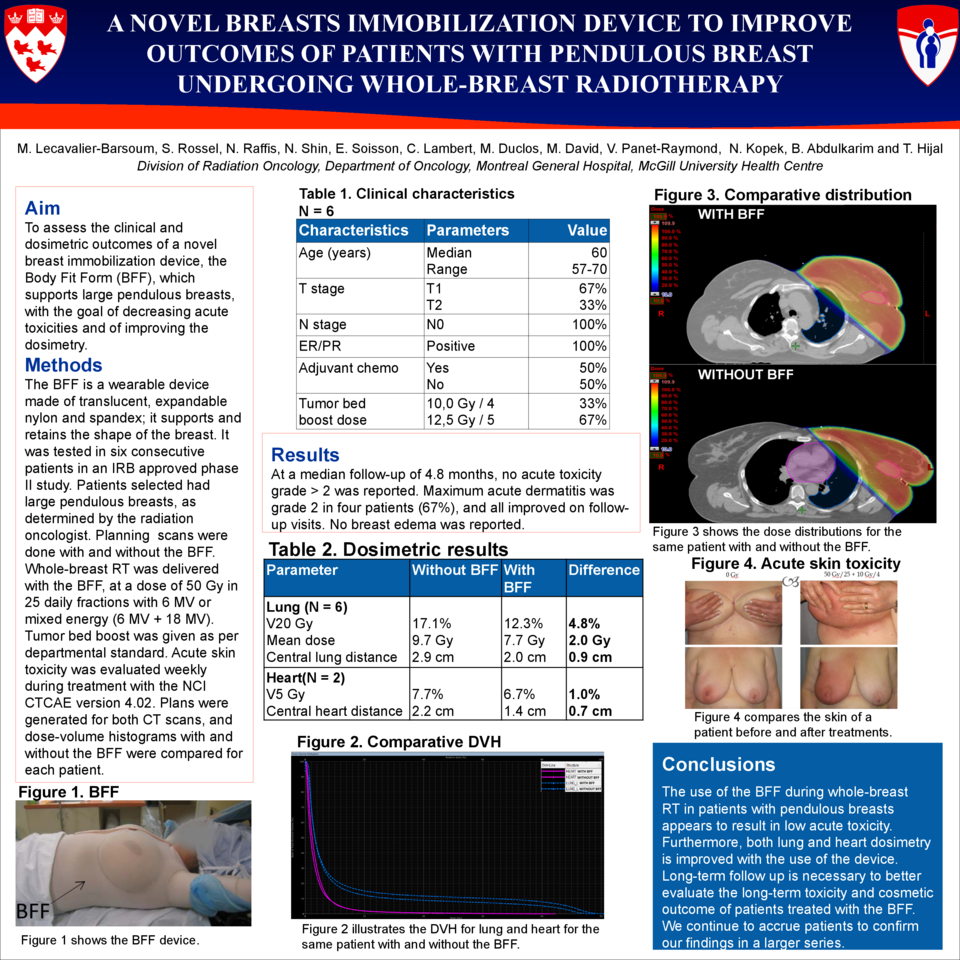Abstract
M Lecavalier-Barsoum, S Rossel, N Raffis, N Shin, E Soisson, C Lambert, M Duclos, M David, V Panet-Raymond, N Kopek, B Abdulkarim, T Hijal
McGill University, Montreal, QC
Purpose: Pendulous breasts are challenging to treat with whole-breast radiotherapy (RT). This study was undertaken to assess the clinical and dosimetric outcomes of a novel breast immobilization device, the Body Fit Form (BFF), which changes the irradiated breast shape, with the goal of decreasing acute toxicities and of improving the dosimetry.
Materials and Methods: The BFF is a wearable device made of translucent, expandable nylon and spandex; it molds and retains the shape of the breast. It was tested in five consecutive patients in an IRB approved Phase II study. Planning computed tomography (CT) scans were done with and without the BFF. Whole-breast RT was delivered with the BFF, at a dose of 50 Gy in 25 daily fractions with photon beams of 6 MV or of mixed energy (6 MV + 18 MV). Tumour bed boost was given as per departmental standard, with either electrons or Intensity Modulated Radiation Therapy. Acute toxicity was evaluated weekly during treatment with the NCI CTCAE version 4.02. Plans were generated for both CT scans, and dose-volume histograms with and without the BFF were compared for each patient.
Results: Median age was 60 (range 57-70). Patients had pT1-2 N0 disease. Two patients received chemotherapy prior to RT. During treatment, no acute toxicity Grade >2 was reported. Maximum acute dermatitis was Grade 2 in three patients (60%), and all improved on follow-up visits. No breast edema was reported. Dosimetry to the lung was improved in all patients. Average ipsilateral lung V20Gy decreased from 20.8% (range 13.3-32.6%) to 13.7% (range 10.9-16.7%), while average lung mean dose decreased from 11.4 Gy (range 8.1-16.9 Gy) to 8.4 Gy (range 7.4-9.3 Gy). In one patient with left-sided breast cancer, cardiac V5Gy and Dmax were of 6.9% and 45.6 Gy for RT with the BFF and 8.5% and 50.4 Gy without the BFF.
Conclusions: The use of the BFF during whole-breast RT in patients with pendulous breasts appears to result in low acute toxicity. Furthermore, both lung and heart dosimetry is improved with the use of the device. Nonetheless, further study is warranted to generalize conclusions, and long-term follow-up is necessary to better evaluate the long-term toxicity and cosmetic outcome of patients treated with the BFF






